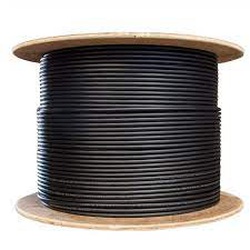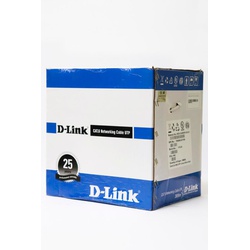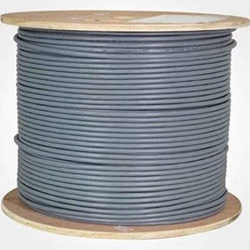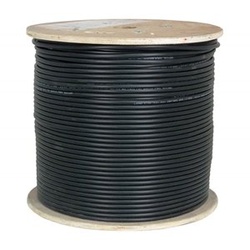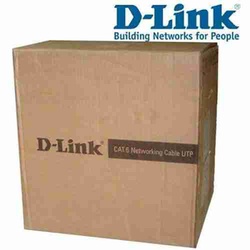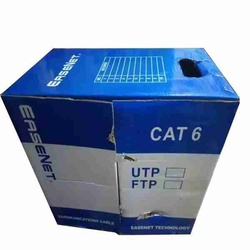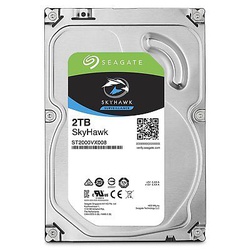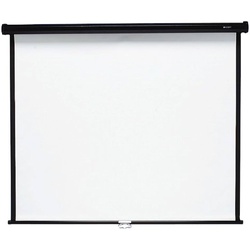
Outdoor Cat 6 Cable Semi-Copper
by Easenet
Outdoor Cat 6 cable, also known as Category 6 cable, is designed for use in outdoor environments. It is a type of Ethernet cable that provides high-speed data transmission and is backward compatible with previous Ethernet standards.
- Weather Resistance: Outdoor Cat 6 cables are designed to withstand outdoor environments, including exposure to sunlight, moisture, and extreme temperatures. They typically have a rugged, UV-resistant outer jacket that provides protection against weather conditions.
- High-Speed Data Transmission: Cat 6 cables are capable of supporting high-speed data transmission up to 10 Gigabit Ethernet (10GbE) over short distances. They offer improved performance and reduced crosstalk compared to previous Ethernet cable standards.
- Twisted Pair Design: Cat 6 cables use a twisted pair design, where each pair of copper conductors is twisted together to minimize electromagnetic interference (EMI) and crosstalk. This design helps maintain signal integrity and data reliability.
- Solid Copper or Copper-Clad Aluminum Conductors: Outdoor Cat 6 cables typically use either solid copper conductors or copper-clad aluminum (CCA) conductors. Solid copper conductors provide better conductivity and performance, while CCA conductors may offer a more cost-effective option.
| SKU | 1260 |
|---|
Reviews
This product does not have any reviews yet.
Add your reviewDescription
Outdoor Cat 6 Cable Semi-Copper
Outdoor Cat 6 cable, also known as Category 6 cable, is designed for use in outdoor environments. It is a type of Ethernet cable that provides high-speed data transmission and is backward compatible with previous Ethernet standards.
The term "Semi-Copper" is not a standard industry term and may refer to a specific variation or construction of the cable. However, in general, Cat 6 cables consist of four pairs of twisted copper wires. Each pair is individually insulated and twisted together to minimize crosstalk and electromagnetic interference (EMI).
In a standard Cat 6 cable, the conductors are typically made of solid copper. However, some variations may use copper-clad aluminum (CCA) conductors, where an aluminum core is coated with a thin layer of copper. This construction helps reduce costs while maintaining acceptable performance. It is important to note that CCA cables may have slightly higher resistance compared to cables with solid copper conductors, which can limit the maximum transmission distance.
The outer jacket of an outdoor Cat 6 cable is made of a rugged, UV-resistant material that provides protection against weather conditions, moisture, sunlight, and other outdoor elements. This jacket ensures the cable's durability and enables it to withstand exposure to harsh environments.
Outdoor Cat 6 cables are designed to support high-speed data transmission up to 10 Gigabit Ethernet (10GbE) over short distances, typically up to 55 meters (180 feet). They are commonly used for outdoor networking applications, such as connecting IP cameras, wireless access points, and other devices in outdoor environments where direct burial or exposure to the elements is necessary.
When selecting an outdoor Cat 6 cable, it is important to ensure that it meets the necessary specifications and certifications for your specific application, such as UL (Underwriters Laboratories) listing for outdoor use, ETL (Electrical Testing Laboratories) verification, or other relevant standards.
General features and characteristics of outdoor Cat 6 cables:
-
Weather Resistance: Outdoor Cat 6 cables are designed to withstand outdoor environments, including exposure to sunlight, moisture, and extreme temperatures. They typically have a rugged, UV-resistant outer jacket that provides protection against weather conditions.
-
High-Speed Data Transmission: Cat 6 cables are capable of supporting high-speed data transmission up to 10 Gigabit Ethernet (10GbE) over short distances. They offer improved performance and reduced crosstalk compared to previous Ethernet cable standards.
-
Twisted Pair Design: Cat 6 cables use a twisted pair design, where each pair of copper conductors is twisted together to minimize electromagnetic interference (EMI) and crosstalk. This design helps maintain signal integrity and data reliability.
-
Solid Copper or Copper-Clad Aluminum Conductors: Outdoor Cat 6 cables typically use either solid copper conductors or copper-clad aluminum (CCA) conductors. Solid copper conductors provide better conductivity and performance, while CCA conductors may offer a more cost-effective option.
-
Ethernet Compatibility: Outdoor Cat 6 cables are backward compatible with previous Ethernet standards, such as Cat 5 and Cat 5e. This means they can be used with devices that support lower Ethernet speeds.
-
Length and Certification: Outdoor Cat 6 cables are available in various lengths to accommodate different installation requirements. It's important to ensure that the cable meets the necessary specifications and certifications for your specific application, such as UL listing for outdoor use, ETL verification, or other relevant standards.

